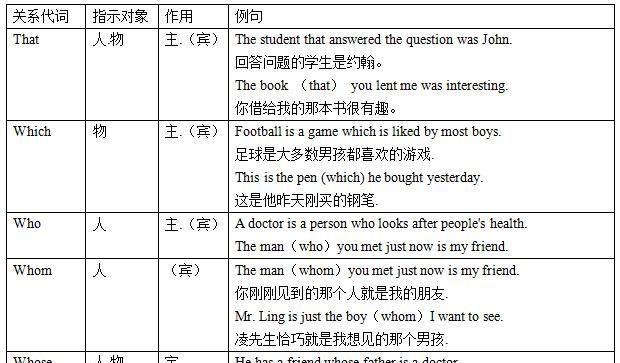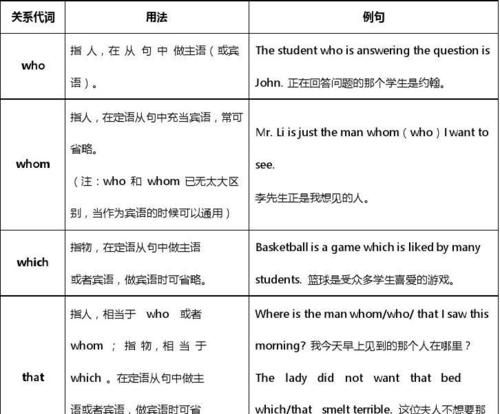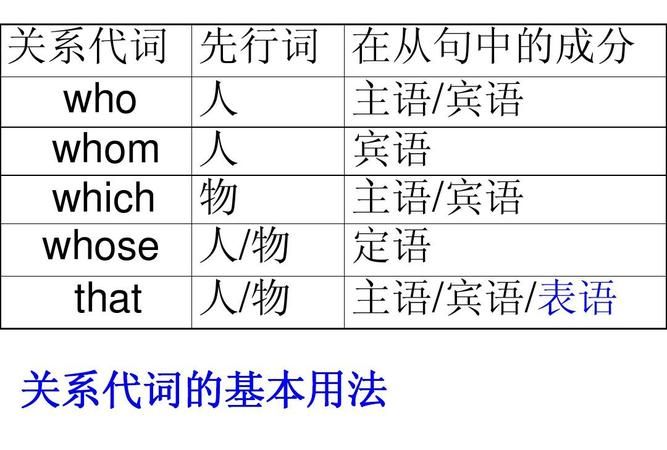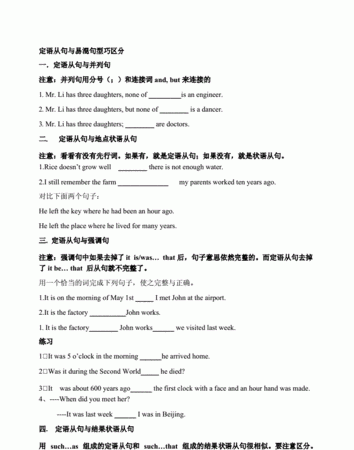本文目录
语文定语从句的几种类型
定语从句的类型
(一) 由 who,whom,whose引导的定语从句
e.g.The student who answered the question was Jack
(二) 由which引导的定语从句
1) which在从句中作主语或谓语动词的宾语。
e.g.:I found a door which was unlocked.
Where is the book I bought yesterday?
2) which(whom)在从句中作介词的宾语时,介词一般可放在which(whom)之前,也可放在从句原来的位置上,在含有介词的动词固定词组中介词只能放在原来的位置上,而不能放在which(whom)之前。
e.g.:Please tell me from whom you borrowed the English novel. (=Please tell me whom you borrowed the English novel from.)This is the magazine which you are looking for. (look for是固定词组)
(三) 由that引导的定语从句在这种定语从句中that可以指人或物,代替who,whom,which,在从句中作主语或谓语动词的宾语(不能放在介词后面作介词宾语)。
e.g.:Would you like to have lunch at a new restaurant I heard about? (that可省略)但下列两种情况只能用that
1) 序数词或最高级形容词修饰先行词时,要用that. e.g.:The first English novel that I read was A Tale of Two Cities by Charles Dickens.
2) all, everything, nothing, something, anything等不定代词作先行词时,要用that。e.g.:Everything that we saw at the Industrial Exhibition greatly interested us.
(四) 由when, where, why引导的定语从句
I will never forget the day when I arrived in London.
. (五) 限制性定语从句和非限制性定语从句限制性定语从句是句中不可缺少的组成部分,如果没有从句,先行词的意思就不明确,主句也不完整,从句和主句之间一般不用逗号分开。
非限制性定语从句是主句先行词的补充说明,没有从句并不影响主句意思的明确或完整,这种定语从句一般用逗号与主句分开。在非限制性定语从句中通常不用关系代词that。
e.g:He once bought a railway ticket for a woman, which was reported in the newspapers.(which代表主句所述事实)
定语从句教案
教学目标
1. 知识目标:掌握下列重点单词和词组的.意思及用法ache, evercise, weight, give up, interest及其词汇转化
2. 能力目标:能够询问有关健康的信息,表达态度,提供建议。学习使用由whose引导的定语从句。
3.情感目标:通过了解tony 的经历,培养体谅、关爱他人的情感态度。
教学重难点
1.重点:对话中的句型应用,由whose引导的定语从句
2.难点:由whose引导的定语从句的运用。
教学工具
课件
教学过程
[课前朗读]: 朗读生词ache, exercise, weight, give up, interest, tasty----taste, menu, persuade.根据音标读出单词并了解汉语意思,养成学生自主学习词汇的习惯,促使学生迅速进入学习状态。
[检查词汇预习]:
a.采取学生结对、小组互查等形式来检查学生对词汇的预习情况。
b.朗读单词,注意发音。
一、情境导入
教师可问学生:(1)What’s your favourite sport?(2) How do you think we can keep fit?(3) Have you ever remembered what happened to Tony in Module9?这样会调动学生用英语思维的积极性, 引出本单元话题。
二、小听力(自主完成,合作释疑)
听Activity 2,完成表格
Betty
Lingling
Taijiquan
Weight
training
Running
针对表格进行说的练习。如:How does Lingling think of Taijiquan and running?
三、大听力 多层听
1.听Activity 3,完成下列各题。
1).Who has Betty bumped into?
A. The head teacher B. The English teacher C.Lingling and Betty
2).Does Daming think that the boy in his team can go to a sports school ?
A. Yes, he does B. No, he doesn’t C. We don’t know
3).What does Daming want the head teacher to write ?
A. Something about staying healthy
B. Something about training for the Olympics
C. something about buying a camera
2. 再听Activity 3,完成下列表格。
1. How did Tony feel
the basketball training? 1. He feels very
2. What will the boy in Daming’s team need to do? 2. He needs to do a lot of___ _____
3. Why isn’t allowed to use his father’s camera any more? 3. Because he almost __ ______ it last time.
四、默读对话,自主完成Activity 4.
完成后小组展示并纠正。小组间合作解决activity 3中不懂的地方,教师适时点拨。
五、突破重点与难点
对重点内容和疑难问题进行合作探究学习。
1.My legs ache a bit. ___________________(翻译)
(1) a bit 译为_____________. 其同义短语是___________.
自主造句:_______________________________.
2. Don’t give up if you want to stay fit.__________________________.
give up, 放弃。其中up是代词,后跟名词作宾语时可放在短语 ,也可放在 ,而跟代词宾语时只能放 。例如:give it/them up放弃做某事----give up doing sth.
自主造句: _______________________.
我们学过的可加动名词的动词或短语有
3.He is not fit or strong enough.____________________________
总结enough 的用法并举例
自主造句:
4. I’ve got a friend whose brother is training for the Olympics.此句含有一个whose 引导的定语从句,whose在从句中作定语,又如:
He is the only student in our class whose father is a policeman.
There is a boy whose parents want him to go to a sports school.
先行词为无生命的物体时也可以用whose 引导定语从句.如:
The book whose cover is green is mine.
No one now lives in the room whose windows are broken.
5.找出含有whose 的定语从句并翻译句子。分析定语从句的先行词。
___________________________________________________.
___________________________________________________.
___________________________________________________.
___________________________________________________.
5. 自主补充完善
六、归纳短语
通过对对话的学习,让学生归纳本课的短语,可以小组合作,然后通过展示呈现出一个小组的成果,然后其他小组补充完善。
1. _____________________ 9._______________________
2. _____________________ 10.______________________
3. _____________________ ______________________
4. _____________________ _______________________
5. _____________________ ______________________
6. _____________________ ______________________
7. _____________________ ______________________
8. _____________________ ______________________
七、诵读积累
(一)跟录音机朗读对话,模仿语音语调。
(二)读熟对话
(三)读烂短语
(四)读烂下列重点句子
1.Don’t give up if you want to stay fit.
2. He isn’t fit or strong enough.
3.I’m not allowed to use it any more.
4.It’s my father who gives me my pocket money.
5. Don’t talk to me about that.
6. What’s up?
7.Guess what?
8. (含有whose的定语从句)
八、说的训练:
Work in pairs. Ask and answer the questions in Activity 5.
九、当堂检测
(一)翻译下列短语及句子:
1.放弃___________________2.一点_____________________________
3.保持健康 _______________ 4.足够强壮_________________
5.碰巧遇到_________________6.发生什么事了?_________________
7.看起来像 ________________ 8.祝你好运 ________________

英语定语从句高级句型
定语从句是由关系代词和关系副词引导的从句,其作用是作定语修饰主句的某个名次性成分,定语从句分为限定性和非限定性从句两种。
一、 限定性定语从句
1. that即可代表事物也可代表人,which代表事物;它们在从句中作主语或宾语,that在从句中作宾语时常可省略关系词,which在从句中作宾语则不能省略。而且,如果which在从句中作“不及物动词+介词”的介词的宾语,注意介词不要丢掉,而且介词总是放在关系代词which的前边,但有的则放在它原来的位置
2. which作宾语时,根据先行词与定语从句之间的语义关系,先行词与which之间的介词不能丢
3. 代表物时多用which,但在带有下列词的句子中用that而不用which,这些词包括all, anything, much等,这时的that常被省略
4. who和whom引导的从句用来修饰人,分别作从句中的主语和宾语,whom作宾语时,要注意它可以作动词的宾语也可以作介词的宾语
5. where是关系副词,用来表示地点的定语从句
6. when引导定语从句表示时间
〔注〕值得一提的是,表示时间“time"一词的定语从句只用when引导,有时不用任何关系代词,当然也不用that引导
By the time you arrive in London, we will have stayed there for two weeks.
I still remember the first time I met her.
Each time he goes to besiness trip, he brings a lot of living necessities, such as towers, soap, toothbrush etc.
7. whose是关系代词,修饰名词作定语,相当于所修饰成分的前置所有格
8. 当从句的逻辑主语是some, any, no, somebody, anybody, nobody, something, anything, everything或nothing时,常用there is来引导
二、非限定性定语从句:非限定性定语从句的作用是对所修饰的成分作进一步说明,通常和主句间用逗号隔开,将从句拿掉后其他部分仍可成立
1. which引导的非限定性定语从句来说明前面整个句子的情况或主句的某一部分
2. 在引导限定性定语从句时,that有时相当于in which, at which, for which或at which
Attitudes towards daydreaming are changing in much the same way that(in which) attitudes towards night dreaming have changed. 人们对白日做梦的态度正在改变,这与人们对夜间做梦的看法的变化有非常相似之处。
I like the music for the very reason that(for which) he dislike it. 我出于某种原因喜欢这种音乐,而他恰恰与我相反。
We arrived the day that(on which) they left. 刚好我们到的那天他们走了。
3. 有时as也可用作关系代词
4. 在非限定性定语从句中,不能用that,而用who, whom代表人,用which代表事物.
一.定语从句及相关术语
1.定语从句:修饰一个名词或代词的从句称为定语从句,一般紧跟在它所修饰的先行词后面。
2.关系词:引导定语从句的关联词成为关系词
关系词有关系代词和关系副词。关系代词有that, which, who, whom, whose, as等;关系副词有where, when, why等。
关系词常有3个作用:1,引导定语从句。2,代替先行词。3,在定语从句中担当一个成分。
二.关系代词引导的定语从句
1.who指人,在从句中做主语
(1) The boys who are playing football are from Class One.
(2) Yesterday I helped an old man who lost his way.
2. whom指人,在定语从句中充当宾语,常可省略。
(1) Mr. Liu is the person (whom) you talked about on the bus.
(2) Mr. Ling is just the boy whom I want to see.
注意:关系代词whom在口语和非正式语体中常用who代替,可省略。
(3) The man who/whom you met just now is my friend.
3. which指物,在定语从句中做主语或者宾语,做宾语时可省略
(1) Football is a game which is liked by most boys.
(2) This is the pen (which) he bought yesterday.
4. that指人时,相当于who或者whom;指物时,相当于which。在宾语从句中做主语或者宾语,做宾语时可省略。
(5) The number of the people that/who come to visit the city each year rises one million.
(6) Where is the man that/whom I saw this morning?
5. whose通常指人,也可指物,在定语从句中做定语
(1) He has a friend whose father is a doctor.
(2) I once lived in a house whose roof has fallen in.
whose指物时,常用以下结构来代替
(3) The classroom whose door is broken will soon be repaired.
(4) The classroom the door of which is broken will soon be repaired.
(5) Do you like the book whose cover is yellow?
(6) Do you like the book the color of which is yellow?
三.介词+关系代词引导的定语从句
关系代词在定语从句中做介词宾语时,从句常由介词+关系代词引导
(1) The school (that/which) he once studied in is very famous.
(2) The school in which he once studied is very famous.
(3) Tomorrow I will bring here a magazine (that/which) you asked for.
(4) Tomorrow I will bring here a magazine for which you asked.
(5) We’ll go to hear the famous singer (whom/that/who) we have often talked about.
(6) We’ll go to hear the famous singer about whom we have often talked.
注意:1. 含有介词的动词短语一般不拆开使用,如:look for, look after, take care of等
(1) This is the watch which/that I am looking for. (T)
(2) This is the watch for which I am looking. (F)
2. 若介词放在关系代词前,关系代词指人时用whom,不可用who或者that;指物时用which,不能用that;关系代词是所有格时用whose
(1) The man with whom you talked is my friend. (T)
(2) The man who/that you talked with is my friend. (F)
(3) The plane in which we flew to Canada is very comfortable. (T)
(4) The plane in that we flew in to Canada is very comfortable. (F)
3. “介词+关系代词”前可有some, any, none, both, all, neither, most, each, few等代词或者数词
(1) He loved his parents deeply, both of whom are very kind to him.
(2) In the basket there are quite many apples, some of which have gone bad.
(3) There are forty students in our class in all, most of whom are from big cities.
四.关系副词引导的定语从句
1. when指时间,在定语从句中做时间状语
(1) I still remember the day when I first came to the school.
(2) The time when we got together finally came.
2. where指地点,在定语从句中做地点状语
(1) Shanghai is the city where I was born.
(2) The house where I lived ten years ago has been pulled down.
3. why指原因,在定语从句中做原因状语
(1) Please tell me the reason why you missed the plane.
(2) I don’t know the reason why he looks unhappy today.
注意:关系副词引导的从句可以由“介词+关系代词”引导的从句替换
(1) The reason why/ for which he refused the invitation is not clear,
(2) From the year when/in which he was going to school he began to know what he wanted when he grew up.
(3) Great changes have taken place in the city in which./where I was born.
五.限制性定语从句和非限制性定语从句
限制性定语从句 非限制性定语从句
形式上 不用逗号和主句隔开 用逗号和主句隔开
意义上 是先行词不可缺少的定语,不能删除 是对先行词的补充说明,删除后意思仍完整
译法上 翻译成先行词的定语,“…的…” 通常翻译成主句的并列句
关系词的使用上 A.做宾语时可省略 B。可用that
C.可用who代替whom A.不可省 B。不用that
C。不用who代替whom
限制性定语从句举例:
(1) The teacher told me that Tom was the only person that I could depend on.
(2) China is a country which has a long history.
非限制性定语从句举例:
(1) His mother, who loves him very much, is strict with him.
(2) China, which was founded in 1949, is becoming more and more powerful.
要注意区分以下几个句子的不同
(1) His brother who is now a doctor always encourages him to go to college.
他那当医生的哥哥常鼓励他要考上大学。(他还有其他的哥哥)
(2) His brother, who is now a doctor, always encourages him to go to college.
他的哥哥是当医生的,常鼓励他要考上大学。(他只有一个哥哥)
难点分析
(一)限制性定语从句只能用that的几种情况
1.当先行词是anything, everything, nothing (something 除外), few, all, none, little, some等代词时,或者是由every, any, all, some, no, little, few, much等修饰时
(1) Have you taken down everything that Mr. Li has said?
(2) There seems to be nothing that seems impossible for him in the world.
(3) All that can be done has been done.
(4) There is little that I can do for you.
注意:当先行词指人时,偶尔也可以用who
(4) Any man that/.who has a sense of duty won’t do such a thing.
2. 当先行词被序数词修饰
(1) The first place that they visited in London was the Big Ben.
3. 当先行词被形容词最高级修饰时
(1) This is the best film that I have seen.
4. 当形容词被the very, the only 修饰时
(1) This is the very dictionary that I want to buy,
(2) After the fire in his house, the old car is the only thing that he owned.
当先行词指人时,偶尔也可以用who
(3) Wang Hua is the only person in our school who will attend the meeting/
5. 当先行词前面有who, which等疑问代词时
(1) Who is the man that is standing there?
(2) Which is the T-shirt that fits me most?
6. 当先行词既有人,也有动物或者物体时
(1) Can you remember the scientist and his theory that we have learned?
(二)关系代词as和which引导的定语从句
as和which引导非限制性定语从句,有相同之处也有不同之处。具体情况是:
1.As和which都可以在定语从句中做主语或者宾语,代表前面整个句子。
(1) He married her, as/which was natural.
(2) He was honest, as/which we can see.
2. as 引导非限制性定语从句,可放在主句之前,或者主句之后,甚至可以切割一个主句;which引导的非限制性定语从句只能放在主句之后。另外,as有“正如……,正像……”的意思
(1) As is known to all, China is a developing country.
(2) He is from the south, as we can see from his accent.
(3) John, as you know, is a famous writer.
(4) He has been to Paris more than several times, which I don’t believe.
注意:当主句和从句存在逻辑上的因果关系时,常用which
(5) Tom was always late for school, which made his teacher angry.
3. 当先行次受such, the same修饰时,常用as
(1) I have never heard such a story as he tells.
(2) He is not such a fool as he looks.
(3) This is the same book as I lost last week.
注意:当先行次由the same修饰时,偶尔也用that引导定语从句,但是和由as所引导的定语从句意思不同
(4) She wore the same dress that she wore at Mary’s wedding. 她穿着她在MARY婚礼上穿过的一条裙子。
(5) She wore the same dress as her young sister wore. 她穿着和她妹妹所穿的一样的裙子。
(三)以the way为先行词的定语从句通常由in which, that引导,而且通常可以省略。
(1) The way in which/ that/./ he answered the question was surprising.
(四) but有时也可以做关系词引导定语从句
(1) There are very few but understand his idea. ( but= who don’t )
(五) 区分定语从句和同位语从句
1.定语从句修饰先行词,它和先行词是修饰关系;同位语从句说明先行词的具体内容,是补充说明的关系
(1) The plane that has just taken off is for London. 定语从句
(2) The fact that he has been dead is clear. 同位于从句
2.定语从句由关系代词或者关系副词引导,关系词在句中充当成分,有时可以省略;同位语从句主要由that引导,在句中一般不做成分;句子也可以由when, where, how, why, whether, what等词引导,充当成分
(1) The news he told me is true.
(2) The news that he has just died is true.
(3) The problem that we are facing now is how we can collect so much money. 定语
(4) The problem how we can collect so much money is difficult to solve.
3. 同位语从句和先行词一般可以用be动词发展成一个完整的句子,而定语从句不可以
(1) The idea that we could ask the teacher for advice is wonderful. 同位语
(2) The idea was that we could ask the teacher for advice.
(3) The fact that the earth moves around the earth is known to all.
(4) The fact is that the earth moves around the earth.

定语从句的句式结构
限制性和非限制性定语从句
1)
定语从句有限制性和非限制性两种。限制性定语从句是先行词不可缺少的部分,去掉它主句意思往往不明确;非限制性定语从句是先行词的附加说明,去掉了也不会影响主句的意思,它与主句之间通常用逗号分开,例如:
this
is
the
house
which
we
bought
last
month.
这是我们上个月买的那幢房子。(限制性)
the
house,
which
we
bought
last
month,
is
very
nice.这幢房子很漂亮,是我们上个月买的。(非限制性)
2)
当先行词是专有
名词或物主代词和指示代词所修饰时,其后的定语从句通常是非限制性的,例如:
charles
smith,
who
was
my
former
teacher,
retired
last
year.
查理·史密斯去年退休了,他曾经是我的老师。
my
house,
which
i
bought
last
year,
has
got
a
lovely
garden.
我去年买的的那幢房子带着个漂亮的花园。
this
novel,
which
i
have
read
three
times,
is
very
touching.
这本小说很动人,我已经读了三遍。
3)
非限制性定语从句还能将整个主句作为先行词,
对其进行修饰,
这时从句谓语动词要用第三人称单数,例如:
he
seems
not
to
have
grasped
what
i
meant,
which
greatly
upsets
me.
他似乎没抓住我的意思,这使我心烦。
liquid
water
changes
to
vapor,
which
is
called
evaporation.
液态水变为蒸汽,这就叫做蒸发。
说明:关系代词that和关系副词why不能引导非限制性定语从句。
介词+关系词
1)介词后面的关系词不能省略。
2)that前不能有介词。
3)
某些在从句中充当时间,地点或原因状语的"介词+关系词"结构可以同关系副词when
和where
互换。
this
is
the
house
in
which
i
lived
two
years
ago.
this
is
the
house
where
i
lived
two
years
ago.
do
you
remember
the
day
on
which
you
joined
our
club?
do
you
remember
the
day
when
you
joined
our
club?
关系代词的用法
(1)
如果先行词是all,
much,
anything,
something,
nothing,
everything,
little,
none等不定代词,关系代词一般只用that,不用which。例如:
all
the
people
that
are
present
burst
into
tears.
(2)
如果先等词被形容词最高级以及first,
last,
any,
only,
few,
mush,
no,
some,
very等词修饰,关系代词常用that,不用which,
who,或whom。例如:
(3)
非限制性定语从句中,不能用关系代词that,作宾语用的关系代词也不能省略。例如:
there
are
about
seven
million
people
taking
part
in
the
election,
most
of
whom、are
well
educated.
如果作先作词的集体名词着眼于集体的整体,关系代词用which;若是指集体中的各个成员,则用who。

定语从句的语法
定语从句
定语从句是由关系代词和关系副词引导的从句,其作用是作定语修饰主句的某个成分,定语从句分为限定性和非限定性从句两种。状语从句分为时间状语从句,结果状语从句,让步状语从句,原因状语从句,条件状语从句以及行为方式状语从句。名词从句包括主语从句,宾语从句,表语从句和同位语从句及there be句型。
一、 限定性定语从句
1. that即可代表事物也可代表人,which代表事物;它们在从句中作主语或宾语,that在从句中作宾语时常可省略关系词,which在从句中作宾语则不能省略。而且,如果which在从句中作“不及物动词+介词”的介词的宾语,注意介词不要丢掉,而且介词总是放在关系代词which的前边,但有的则放在它原来的位置
2. which作宾语时,根据先行词与定语从句之间的语义关系,先行词与which之间的介词不能丢
3. 代表物时多用which,但在带有下列词的句子中用that而不用which,这些词包括all, anything, much等,这时的that常被省略
4. who和whom引导的从句用来修饰人,分别作从句中的主语和宾语,whom作宾语时,要注意它可以作动词的宾语也可以作介词的宾语
5. where是关系副词,用来表示地点的定语从句
6. when引导定语从句表示时间
〔注〕值得一提的是,表示时间“time"一词的定语从句只用when引导,有时不用任何关系代词,当然也不用that引导
By the time you arrive in London, we will have stayed there for two weeks.
I still remember the first time I met her.
Each time he goes to besiness trip, he brings a lot of living necessities, such as towers, soap, toothbrush etc.
7. whose是关系代词,修饰名词作定语,相当于所修饰成分的前置所有格
8. 当从句的逻辑主语是some, any, no, somebody, anybody, nobody, something, anything, everything或nothing时,常用there is来引导
二、非限定性定语从句:非限定性定语从句的作用是对所修饰的成分作进一步说明,通常和主句间用逗号隔开,将从句拿掉后其他部分仍可成立
1. which引导的非限定性定语从句来说明前面整个句子的情况或主句的某一部分
2. 在引导限定性定语从句时,that有时相当于in which, at which, for which或at which
Attitudes towards daydreaming are changing in much the same way that(in which) attitudes towards night dreaming have changed. 人们对白日做梦的态度正在改变,这与人们对夜间做梦的看法的变化有非常相似之处。
I like the music for the very reason that(for which) he dislike it. 我出于某种原因喜欢这种音乐,而他恰恰与我相反。
We arrived the day that(on which) they left. 刚好我们到的那天他们走了。
3. 有时as也可用作关系代词
4. 在非限定性定语从句中,不能用that,而用who, whom代表人,用which代表事物.
一.定语从句及相关术语
1.定语从句:修饰一个名词或代词的从句称为定语从句,一般紧跟在它所修饰的先行词后面。
2.关系词:引导定语从句的关联词成为关系词
关系词有关系代词和关系副词。关系代词有that, which, who, whom, whose, as等;关系副词有where, when, why等。
关系词常有3个作用:1,引导定语从句。2,代替先行词。3,在定语从句中担当一个成分。
二.关系代词引导的定语从句
1.who指人,在从句中做主语
(1) The boys who are playing football are from Class One.
(2) Yesterday I helped an old man who lost his way.
2. whom指人,在定语从句中充当宾语,常可省略。
(1) Mr. Liu is the person (whom) you talked about on the bus.
(2) Mr. Ling is just the boy whom I want to see.
注意:关系代词whom在口语和非正式语体中常用who代替,可省略。
(3) The man who/whom you met just now is my friend.
3. which指物,在定语从句中做主语或者宾语,做宾语时可省略
(1) Football is a game which is liked by most boys.
(2) This is the pen (which) he bought yesterday.
4. that指人时,相当于who或者whom;指物时,相当于which。在宾语从句中做主语或者宾语,做宾语时可省略。
(5) The number of the people that/who come to visit the city each year rises one million.
(6) Where is the man that/whom I saw this morning?
5. whose通常指人,也可指物,在定语从句中做定语
(1) He has a friend whose father is a doctor.
(2) I once lived in a house whose roof has fallen in.
whose指物时,常用以下结构来代替
(3) The classroom whose door is broken will soon be repaired.
(4) The classroom the door of which is broken will soon be repaired.
(5) Do you like the book whose cover is yellow?
(6) Do you like the book the color of which is yellow?
三.介词+关系代词引导的定语从句
关系代词在定语从句中做介词宾语时,从句常由介词+关系代词引导
(1) The school (that/which) he once studied in is very famous.
(2) The school in which he once studied is very famous.
(3) Tomorrow I will bring here a magazine (that/which) you asked for.
(4) Tomorrow I will bring here a magazine for which you asked.
(5) We’ll go to hear the famous singer (whom/that/who) we have often talked about.
(6) We’ll go to hear the famous singer about whom we have often talked.
注意:1. 含有介词的动词短语一般不拆开使用,如:look for, look after, take care of等
(1) This is the watch which/that I am looking for. (T)
(2) This is the watch for which I am looking. (F)
2. 若介词放在关系代词前,关系代词指人时用whom,不可用who或者that;指物时用which,不能用that;关系代词是所有格时用whose
(1) The man with whom you talked is my friend. (T)
(2) The man who/that you talked with is my friend. (F)
(3) The plane in which we flew to Canada is very comfortable. (T)
(4) The plane in that we flew in to Canada is very comfortable. (F)
3. “介词+关系代词”前可有some, any, none, both, all, neither, most, each, few等代词或者数词
(1) He loved his parents deeply, both of whom are very kind to him.
(2) In the basket there are quite many apples, some of which have gone bad.
(3) There are forty students in our class in all, most of whom are from big cities.
四.关系副词引导的定语从句
1. when指时间,在定语从句中做时间状语
(1) I still remember the day when I first came to the school.
(2) The time when we got together finally came.
2. where指地点,在定语从句中做地点状语
(1) Shanghai is the city where I was born.
(2) The house where I lived ten years ago has been pulled down.
3. why指原因,在定语从句中做原因状语
(1) Please tell me the reason why you missed the plane.
(2) I don’t know the reason why he looks unhappy today.
注意:关系副词引导的从句可以由“介词+关系代词”引导的从句替换
(1) The reason why/ for which he refused the invitation is not clear,
(2) From the year when/in which he was going to school he began to know what he wanted when he grew up.
(3) Great changes have taken place in the city in which./where I was born.
五.限制性定语从句和非限制性定语从句
限制性定语从句 非限制性定语从句
形式上 不用逗号和主句隔开 用逗号和主句隔开
意义上 是先行词不可缺少的定语,不能删除 是对先行词的补充说明,删除后意思仍完整
译法上 翻译成先行词的定语,“…的…” 通常翻译成主句的并列句
关系词的使用上 A.做宾语时可省略 B。可用that
C.可用who代替whom A.不可省 B。不用that
C。不用who代替whom
限制性定语从句举例:
(1) The teacher told me that Tom was the only person that I could depend on.
(2) China is a country which has a long history.
非限制性定语从句举例:
(1) His mother, who loves him very much, is strict with him.
(2) China, which was founded in 1949, is becoming more and more powerful.
要注意区分以下几个句子的不同
(1) His brother who is now a doctor always encourages him to go to college.
他那当医生的哥哥常鼓励他要考上大学。(他还有其他的哥哥)
(2) His brother, who is now a doctor, always encourages him to go to college.
他的哥哥是当医生的,常鼓励他要考上大学。(他只有一个哥哥)
难点分析
(一)限制性定语从句只能用that的几种情况
1.当先行词是anything, everything, nothing (something 除外), few, all, none, little, some等代词时,或者是由every, any, all, some, no, little, few, much等修饰时
(1) Have you taken down everything that Mr. Li has said?
(2) There seems to be nothing that seems impossible for him in the world.
(3) All that can be done has been done.
(4) There is little that I can do for you.
注意:当先行词指人时,偶尔也可以用who
(4) Any man that/.who has a sense of duty won’t do such a thing.
2. 当先行词被序数词修饰
(1) The first place that they visited in London was the Big Ben.
3. 当先行词被形容词最高级修饰时
(1) This is the best film that I have seen.
4. 当形容词被the very, the only 修饰时
(1) This is the very dictionary that I want to buy,
(2) After the fire in his house, the old car is the only thing that he owned.
当先行词指人时,偶尔也可以用who
(3) Wang Hua is the only person in our school who will attend the meeting/
5. 当先行词前面有who, which等疑问代词时
(1) Who is the man that is standing there?
(2) Which is the T-shirt that fits me most?
6. 当先行词既有人,也有动物或者物体时
(1) Can you remember the scientist and his theory that we have learned?
(二)关系代词as和which引导的定语从句
as和which引导非限制性定语从句,有相同之处也有不同之处。具体情况是:
1.As和which都可以在定语从句中做主语或者宾语,代表前面整个句子。
(1) He married her, as/which was natural.
(2) He was honest, as/which we can see.
2. as 引导非限制性定语从句,可放在主句之前,或者主句之后,甚至可以切割一个主句;which引导的非限制性定语从句只能放在主句之后。另外,as有“正如……,正像……”的意思
(1) As is known to all, China is a developing country.
(2) He is from the south, as we can see from his accent.
(3) John, as you know, is a famous writer.
(4) He has been to Paris more than several times, which I don’t believe.
注意:当主句和从句存在逻辑上的因果关系时,常用which
(5) Tom was always late for school, which made his teacher angry.
3. 当先行次受such, the same修饰时,常用as
(1) I have never heard such a story as he tells.
(2) He is not such a fool as he looks.
(3) This is the same book as I lost last week.
注意:当先行次由the same修饰时,偶尔也用that引导定语从句,但是和由as所引导的定语从句意思不同
(4) She wore the same dress that she wore at Mary’s wedding. 她穿着她在MARY婚礼上穿过的一条裙子。
(5) She wore the same dress as her young sister wore. 她穿着和她妹妹所穿的一样的裙子。
(三)以the way为先行词的定语从句通常由in which, that引导,而且通常可以省略。
(1) The way in which/ that/./ he answered the question was surprising.
(四) but有时也可以做关系词引导定语从句
(1) There are very few but understand his idea. ( but= who don’t )
(五) 区分定语从句和同位语从句
1.定语从句修饰先行词,它和先行词是修饰关系;同位语从句说明先行词的具体内容,是补充说明的关系
(1) The plane that has just taken off is for London. 定语从句
(2) The fact that he has been dead is clear. 同位于从句
2.定语从句由关系代词或者关系副词引导,关系词在句中充当成分,有时可以省略;同位语从句主要由that引导,在句中一般不做成分;句子也可以由when, where, how, why, whether, what等词引导,充当成分
(1) The news he told me is true.
(2) The news that he has just died is true.
(3) The problem that we are facing now is how we can collect so much money. 定语
(4) The problem how we can collect so much money is difficult to solve.
3. 同位语从句和先行词一般可以用be动词发展成一个完整的句子,而定语从句不可以
(1) The idea that we could ask the teacher for advice is wonderful. 同位语
(2) The idea was that we could ask the teacher for advice.
(3) The fact that the earth moves around the earth is known to all.
(4) The fact is that the earth moves around the earth.
希望我的答案能助你一臂之力!!!!!

以上就是关于定语从句五种基本句型 ,语文定语从句的几种类型的全部内容,以及定语从句五种基本句型 的相关内容,希望能够帮到您。

